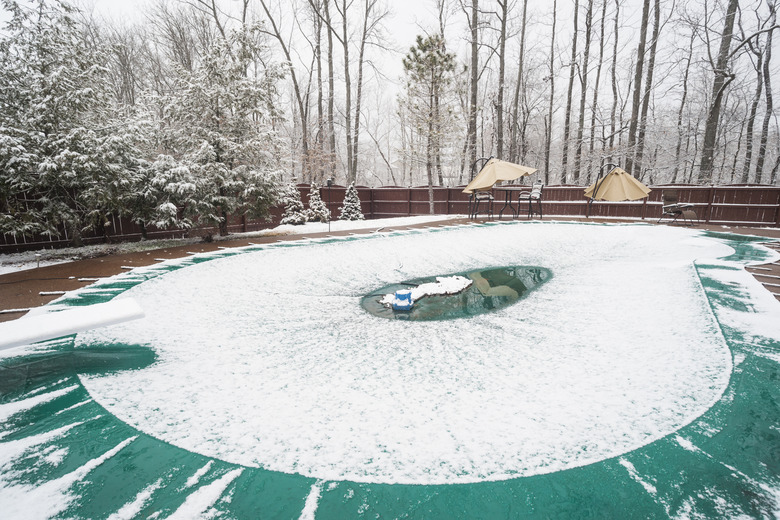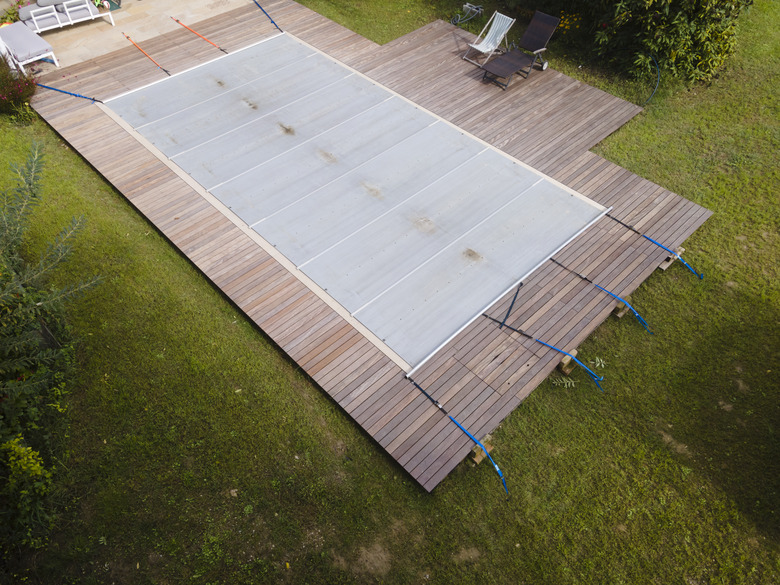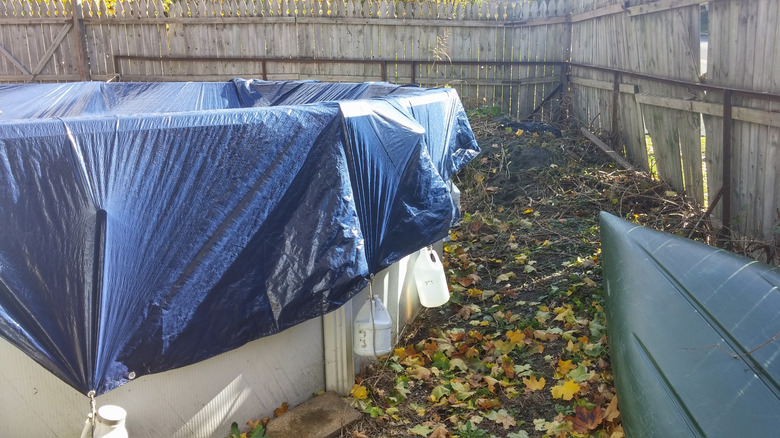How To Winterize A Swimming Pool
We may receive a commission on purchases made from links.
Unless you are lucky enough to live in a tropical climate where a swimming pool is used year-round, winterizing a swimming pool will be necessary before you can let it sit idle for the months it is inactive. The idle period may be only a few weeks in places like Arizona or Florida, or it may be six months or more if you live in a northern climate, like Minnesota or Maine. Either way, there will be a winterization routine to go through as part of your annual pool maintenance.
Winterizing is usually done to prevent freeze damage to the pool and pump caused by frigid temperatures, but it may also be done simply to protect the pool if you happen to be leaving home for an extended period. In a southern climate, for example, you may winterize the pool if you are leaving for vacation even if freezing temperatures aren't an issue.
Here's a breakdown of how to winterize a pool — so you can save on expensive repairs and make your pool last longer.
What Happens if You Don't Winterize Your Pool?
What Happens if You Don't Winterize Your Pool?
Pool owners are supposed to winterize each year, but have you ever wondered what would happen if you just skipped this particular chore? The answer is: nothing good. For starters, you'll absolutely need to keep your pool pump running almost nonstop all winter to try to prevent freezing pipes, and that gets expensive quickly. Freezing can damage pipes, pumps, pool heaters, and the pool itself. Pipes embedded under a concrete pool deck can also damage the deck if they burst.
A pool can also promote algae and bacteria growth in the winter. No swimmers usually means no chemical upkeep, and this can prove just as damaging to the pool in the winter as it does in the summer. Failure to winterize your pool can also result in damage if snow-laden tree limbs or other debris fall into the pool. In short, skipping pool winterization can cause a lot of expensive damage.
When to Winterize a Pool
When to Winterize a Pool
When you winterize depends on the climate in your area. Generally, however, you should close a pool:
- In late September or early October
- By Thanksgiving at the latest in warmer areas
- Before nighttime temperatures drop to 32 degrees Fahrenheit
As soon as it's the off-season for swimming, it is generally time to begin thinking about winterizing it. For many homeowners, Labor Day weekend marks the time for winterizing the pool, but this may vary depending on where you live. In any case, you want the winterizing routine to be finished well before temperatures begin to dip to 32 degrees or below. If you have an unseasonable cold snap before you've winterized the pool, you can help prevent freezing by leaving the filter pump running since running water is less likely to freeze. In any case, it is wise to have the pool winterized and covered by October or by Thanksgiving at the latest.
Things Needed
-
Automated pool cleaner (optional)
-
Winterizing plugs (optional)
-
Inflatable pillow (optional for an in-ground pool)
-
Water bags (optional)
How to Winterize a Pool
How to Winterize a Pool
The details on how to winterize a pool vary slightly for in-ground pools and above-ground pools, but the basic procedure is the same.
1. Clean the Pool
Your pool will better weather the winter if it's as clean as possible before you cover it. This involves several different steps: scrubbing away any visible stains or algae from the walls of the pool, using a leaf net or hand skimmer to remove as much debris as you can, running the automated cleaner (if you have one) over the bottom of the pool and then removing it and putting it away, and finally running the filter for an extended period to clean the pool water as thoroughly as possible.
2. Lower the Water
The next step is to drain water from the pool to the level recommended by your pool dealer or a pool professional. This often means the water level should be between 1 and 12 inches below the level of the skimmer, but always follow the recommendations of the pros. The cover manufacturer may also provide instructions on the proper water level for the winter period.
3. Test and Balance the Water
Now, it's time to test and adjust the pH and chemical levels of the water, using the same test kit you use to maintain your pool through the swimming season. Some experts recommend setting the chemical levels slightly higher for the winter since the levels will drop slightly over the winter.
The pH levels should typically be in the range of 7.2 to 7.6. Optimal chemical levels are:
- Free chlorine: 1.0 to 3.0 ppm
- Total alkalinity: 80 to 150 ppm
- Calcium hardness: 175 to 275 ppm
- Combined chlorine: 0.2 ppm and below
4. Add Winterizing Chemicals
If it's recommended by the manufacturer of your pool's filter system, add winterizing chemicals to your pool. Sometimes sold as "pool-closing kits," these chemicals will keep the pool protected and keep the pool walls clean over the winter. Some kits use slow-dissolve floaters that gradually release chemicals over several months. Some winterizing kits recommend using pool shock or algaecide to add a burst of chemicals to protect against algae growth in the winter. This step should be done right before covering the pool.
5. Clean the Pool Filter
Follow the manufacturer's instructions to clean the filters and water return lines of your pump system. With cartridge filters, this is usually just a matter of removing and cleaning the cartridge and connector hoses and storing them. Diatomaceous earth and sand filters can be a little more complicated, so follow the manufacturer's instructions for the recommended backwashing method. You should also drain booster pumps, chlorinators, or other components that are part of the system.
6. Blow Out Water Lines
Fully removing all water from the pump lines is a good idea, especially if you live in a climate where freezing winter temperatures are likely. This can be done with an air compressor or sometimes even with a powerful wet-dry shop vac. Be thorough with this step and remove as much water as possible from all components of the pump and water lines.
7. Remove/Replace Drain Plugs
Remove all the drain plugs from the pump system. If you wish, you can store these in the skimmer basket and put them away in a safe place. The drain plugs may be a little tricky to find, so refer to the pump instructions to locate them.
If recommended, replace the drain plugs with special expansion plugs, sometimes called winterizing plugs. These are expandable plugs designed to prevent damage from freezing water, and their use is recommended in regions with frigid winters. In regions with especially cold winter months, the pump manufacturer may also recommend adding a pool antifreeze to the pump lines.
8. Shut Off the Power
Make sure the pool pump is disconnected from electrical power to prevent accidental startup that can damage the pump if it operates without water in the system. This can be done by simply shutting off the circuit breaker controlling the pump. It's also a good idea to clear the pump timer so that if the breaker is inadvertently turned on, the pump won't run.
9. Remove Deck Equipment
Most people like to remove all miscellaneous pool equipment that's attached, including rails, skimmer baskets, eye fittings, ropes, ladders, and diving boards. Store everything where it will be protected from winter weather.
10. Cover the Pool
The last step is to cover the pool for the winter. This will prevent debris from falling into the pool and will also protect the pool from sunlight and algae until next spring when you reopen. Covering the pool will also help keep the water chemistry more stable. Additionally, this will act as a safety cover to protect small children and animals from falling in accidentally. Make sure the winter cover is in good condition without any tears or holes. Minor damage can be patched with repair tape.
If you live in an area where deep, prolonged freezes during winter are common, you can place an inflatable air pillow in the center of your pool before covering it. Although this isn't really necessary for an in-ground pool, the pillow will support the center of the cover and lessen the stress on it if the snow piles up.
If you want to use water bags to hold down the pool cover, make sure to fill these only 1/2 to 3/4 full for the winter. This will prevent them from breaking should cold temperatures make the water freeze and expand.
Winterizing Above-Ground Pools
Winterizing Above-Ground Pools
Permanent above-ground pools are winterized using the same steps as for in-ground pools, with an above-ground pool, you definitely need to insert an inflatable pillow under your pool cover to act as an ice compensator if there's a possibility of a deep freeze, and you must remove all the above-ground water lines and store them for the winter. Drain the pool lines and let them dry completely before you store them in a dry location.
A portable above-ground pool must be fully drained before you disassemble it and roll up the liner. Make sure the water is correctly balanced before draining so it won't damage the environment. Once the liner is completely dry, roll it up and store it in a dry location.
Winterizing Saltwater Pools
Winterizing Saltwater Pools
Although saltwater pools are winterized in much the same way as freshwater pools, there is one critical difference. After lowering the water level, turn off all the equipment and then disconnect and remove the salt-generator cell and replace it with a dummy bypass cell, like this one from Pentair. Clean out the salt-generator cell and store it. Then, continue with the other steps for winterization.


